KATHMANDU: As of Friday, a total of 46 expedition teams have been granted mountain climbing permits for this spring, according to the Department of Tourism.
The government has collected over Rs 255.6 million through the permits.
The teams receiving the climbing permits comprise 193 members. Of the collected revenue, Rs 240 million is collected from the mountaineering teams climbing the Mount Everest. As many as 19 teams are attempting to scale the world’s highest peak this time.
According to the Department, aspiring climbers have started flocking the destinations. Four expeditions are attempting each for climbing the Kanchenjunga and Lhotse peaks and two are each for the Annapurna and Ama Dablam, Department’s mountaineering section’s Nayab Subba Rameshwor Niruala said.
Permits have been given to two groups each for climbing Makalu, Nuptse and Gyalzen peaks.
The government has presently opened 415 mountain peaks for climbing and there are still over 1,300 mountains suitable for climbing.
KATHMANDU: Reaching atop the Everest can be a lifelong dream for an adventurer. In fact, a substantial number of tourists visit this Himalayan country, Nepal, with a long-cherished dream of ascending the Mt. Everest, the world’s highest peak.
So far, more than 9,000 people have successfully conquered the world’s highest summit after Tenzing Norgay Sherpa and Edmund Hillary set their feet atop the summit, 8,848 meters, on May 29, 1953.
“Oh, in fact, I have no words to describe the feeling when I reached atop the Everest at the age of 19,” a cheerful Mingma recalls the ‘joyous’ moment.
Every year, Mount Everest attracts scores of audacious travelers and mountaineers, who believe reaching the top of the world is something more than finding the Holy Grail despite all odds. They risk avalanches, storms, ‘death zones’ and harsh temperatures in an attempt to summit the peak.
The success rate of climbing the mountain is getting high, due to the experienced Sherpas who have spent several years in the mountains, claims Mingma Gyabu Sherpa, a guide.
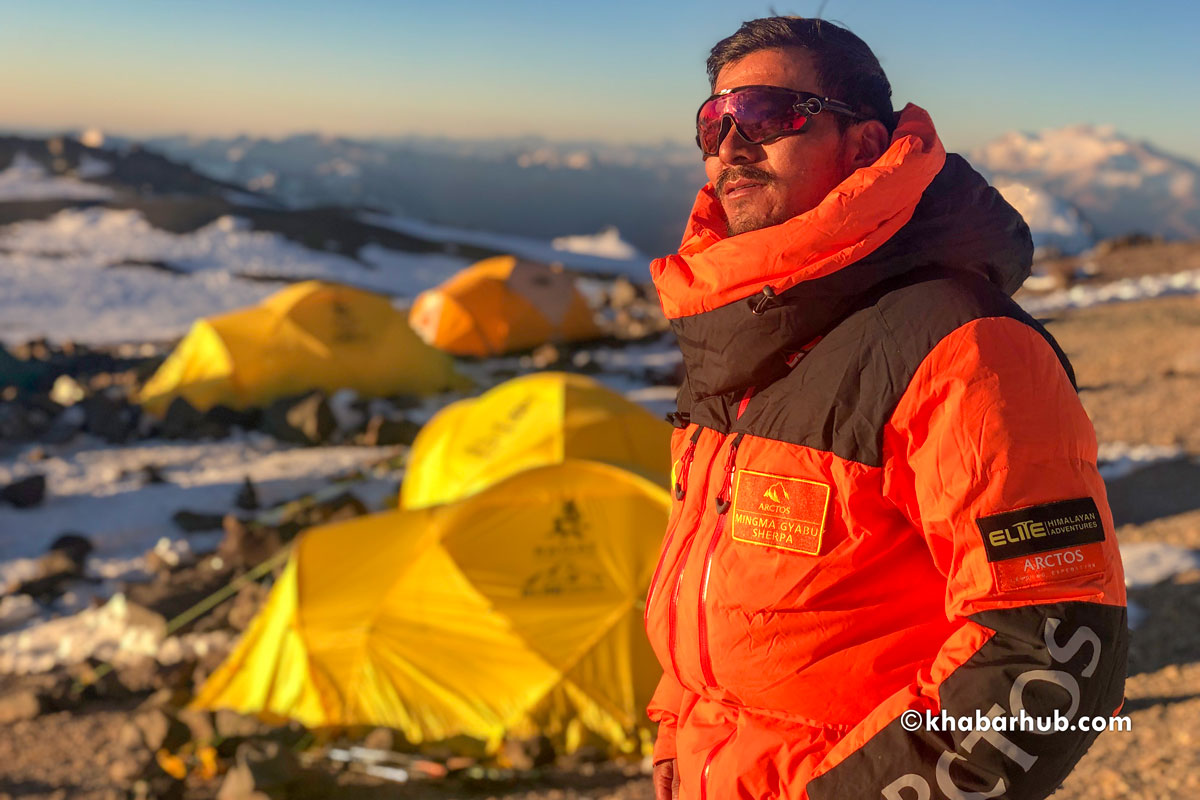
Born on May 16, 1989, in Taplejung, Mingma started his career as a porter in 2009. Full of enthusiasm and confidence, Mingma set on a mission to ascend the Everest in 2010 and succeeded in reaching the top of the world.
Talking with Khabarhub, Mingma recalled one of his neighbors, Dorje Khatri (died in 2014 due to the avalanche at Everest Base Camp), who encouraged him to climb the peak. “In fact, Khatri boosted my confidence,” Mingma said while recalling what Khatri had told him once: “Never look back”. In fact, Mingma never looked back. His only aim was to conquer the world’s tallest peak. And, he did it!
He, however, appealed to the government to categorize mountaineering guides and provide them with social security.
“Oh, in fact, I have no words to describe the feeling when I reached atop the Everest at the age of 19,” a cheerful Mingma recalls the ‘joyous’ moment.
Sharing what goes inside a mountaineer after conquering a peak, he said that summiteers become speechless for a moment. “You can’t express the moment once you set your feet there,” he quips.
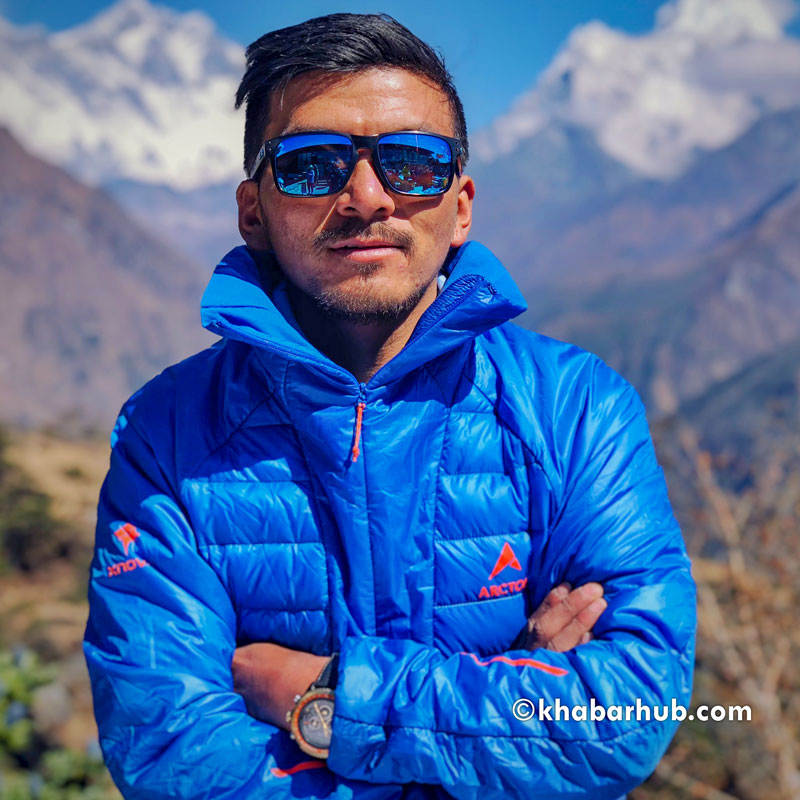
It was in 2016 when Mingma, along with a team of five Sherpas, organized a rescue operation at the height of 8,600 meters of the Everest. He reminisces the moment when after three unceasing hours of struggle, they found two climbers — Chetana Sahu, 43, from Odisha’s Cuttack district in India and Phurba Sherpa – who were struggling for life.
“Both of them were in a critical condition with their supplementary oxygen running out. We safely took them to the South Col, the sharp-edged col between Mount Everest and Lhotse. They were so gratified that they told us we gave them a new life,” Mingma recalls those moments with pride.
In the course of time, Mingma was honored with Piolets d’Or Asia Awards under the Sherpa category for his commitment to technical face climbing and positive environmental stewardship in the mountains. The award aims to encourage and inspire Asian mountaineers who achieved pure and visionary ascents. With the award, he was recognized as the Sherpa of the Year 2019.
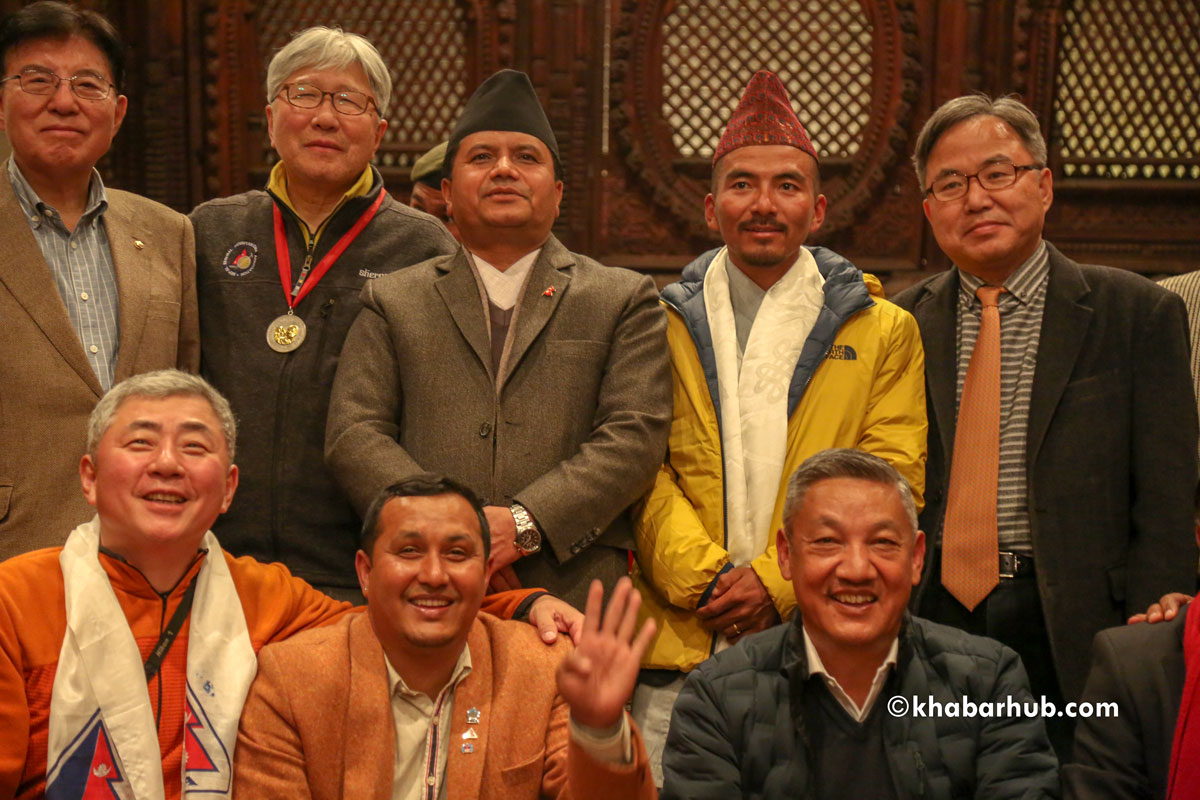
“There was no incident that made me look back or quit mountaineering. It was my dream and I have succeeded in all attempts I have so far made,” a contented Mingma told Khabarhub.
He, however, appealed to the government to categorize mountaineering guides and provide them with social security.
Mingma, however, is worried about the difficulties in climbing the Everest in recent times. “In fact, climbing the Everest has become tougher due to global warming,” he said, adding, “The Khumbu Icefall is melting faster due to global warming. Despite this, the climbing seems easy due to experienced guides and sophisticated equipment they use,” he shared.
Mingma claims that he is not climbing the mountains for records. His dream is to climb successfully 14 peaks and 7 summits.
In 2017, a British Gurkha soldier, Hari Budha Magar, who lost both his legs in Afghanistan, scripted history by successfully standing atop Mera Peak (6,476m) in the autumn climbing season. Magar became the first double amputee above the knee to climb the country’s highest trekking peak in the autumn season. Mingma had led Magar successfully to the peak.
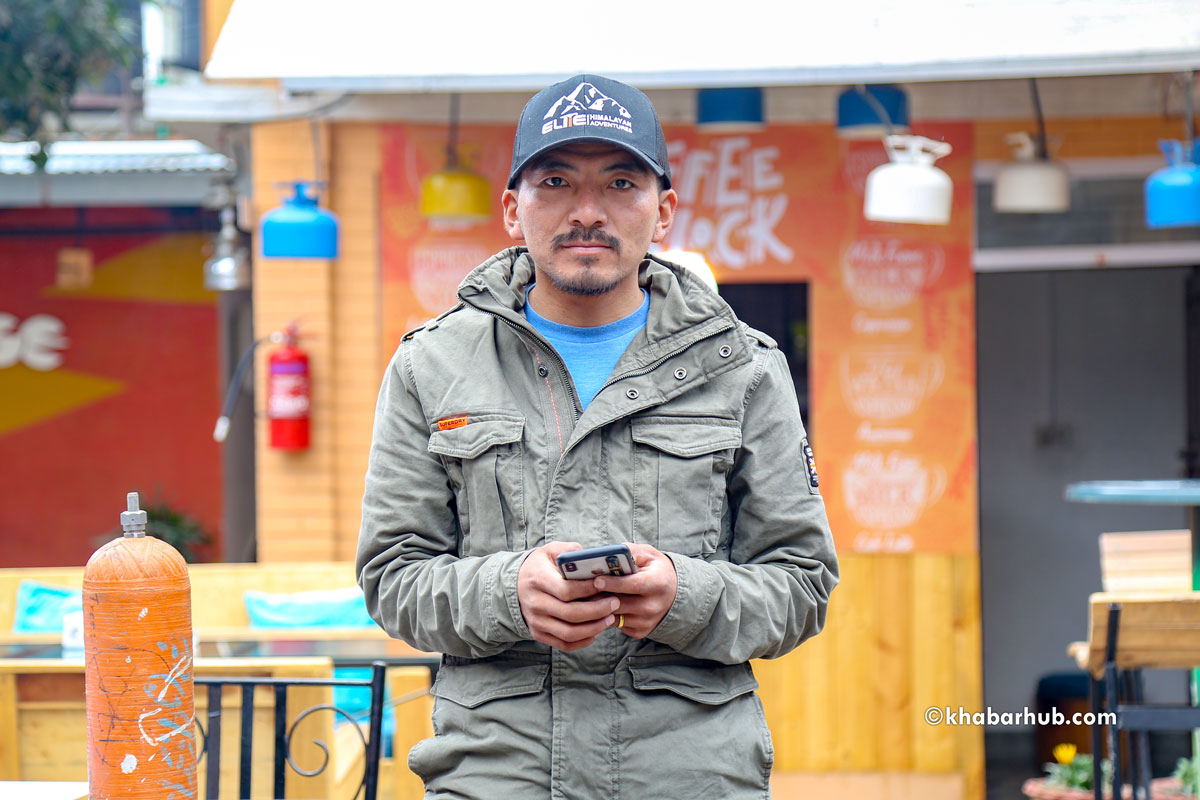
Mingma says foreigners climb the mountains because of their interest, as well as to set a record. Mountaineers reply on the courageous Sherpas while climbing the Everest.
In the current year, Mingma successfully climbed Island Peak and is on the way to climb Mt. Annapurna (8,091m). He will then climb Mt. Dhaulagiri (8,167m), and Mt. Kanchanjunga (8,586m) in the same season. Likewise, he is also planning to climb four mountains of Pakistan.
Mingma claims that he is not climbing the mountains for records. His dream is to climb successfully 14 peaks and 7 summits.
Manaslu Base Camp, 4800m, trek has always been a fascinating route for trekkers and climbers. Also dubbed as an untouched paradise, it has been one of the most popular trekking destinations in Nepal.
Officially opened in 1992, the base camp route is considered as an adventure trek for travelers.
In fact, Manaslu trek offers an absolute view of the mountain peaks, rich cultural heritage, breathtaking panorama as well as rural civilization. To add more, it has an incomparable beauty blended with the natural assortment.
The majestic Mt. Manaslu, 8163m, which is one of the eight tallest mountains in the world, stands tall with its name “The Spirit-Mountain” in the local language.
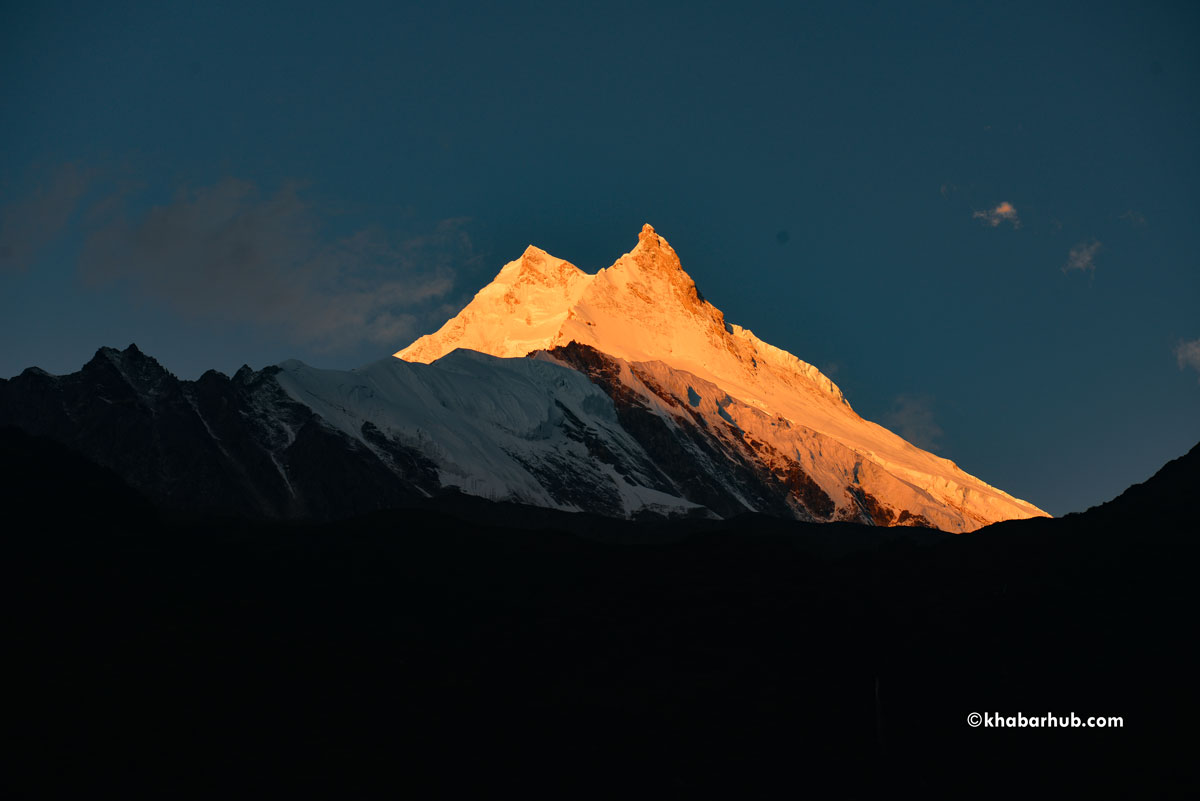
The sunrise view of Mt. Manaslu Main 8163m (L) and East pinnacle 7992m (L), seen from the renowned village Samagoan (3520m) of Gorkha.
Trek to the Manaslu Base Camp can be a blend of an unforgettable experience and wonderful adventure.
Trek to the Manaslu Base Camp begins from Sotikhola Bazar to Budhi Gandaki passing through steep yet picturesque valleys.
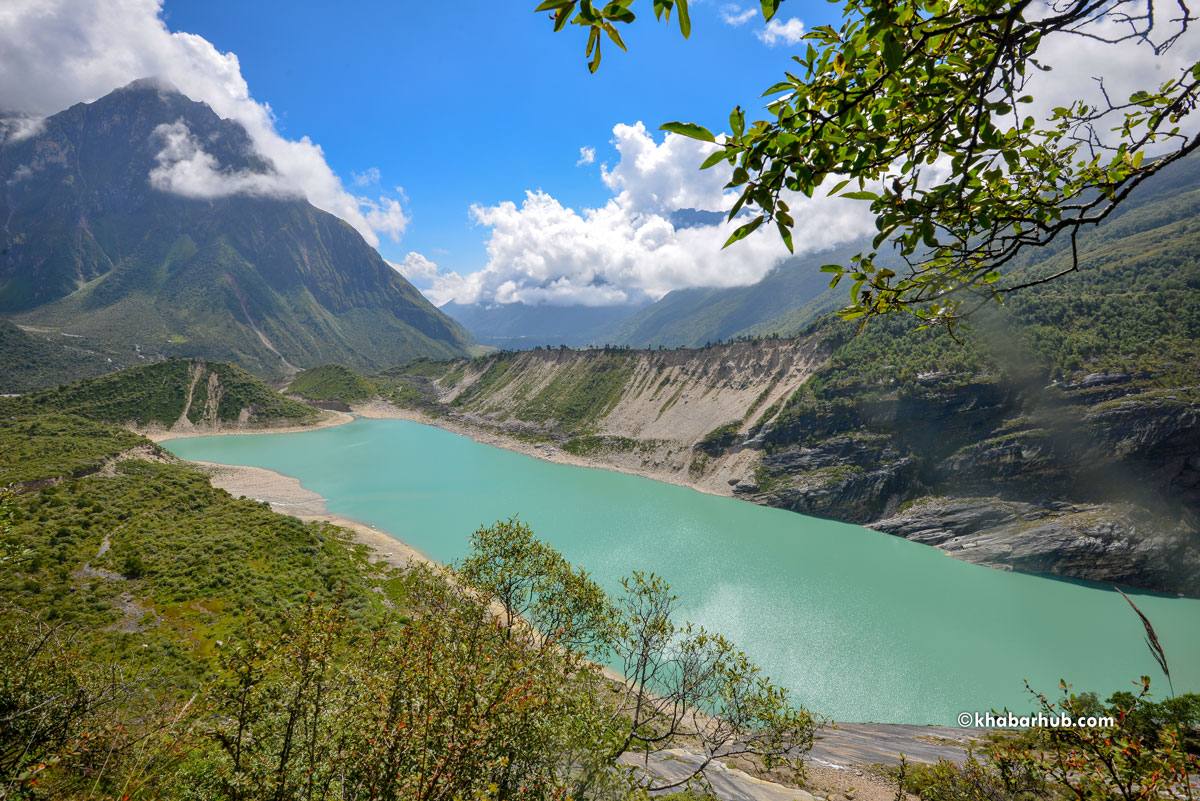
Magnificent view of Birendra Tal seen on the way to the Manalsu Base Camp.
The Manaslu base camp trek begins from Kathmandu to Arughat in Gorkha district. The 18-day trek will lead a traveler through the banks of the Budi Gandaki River passing through scenic valleys, green hills, ridges, jungles, prayer flags, Buddhist monasteries, typical villages, and what not!
The best time of Manaslu trekking begins from September, October and November or March, April and May. Trekkers are usually not recommended to go for trekking from June to August, which is a monsoon season.
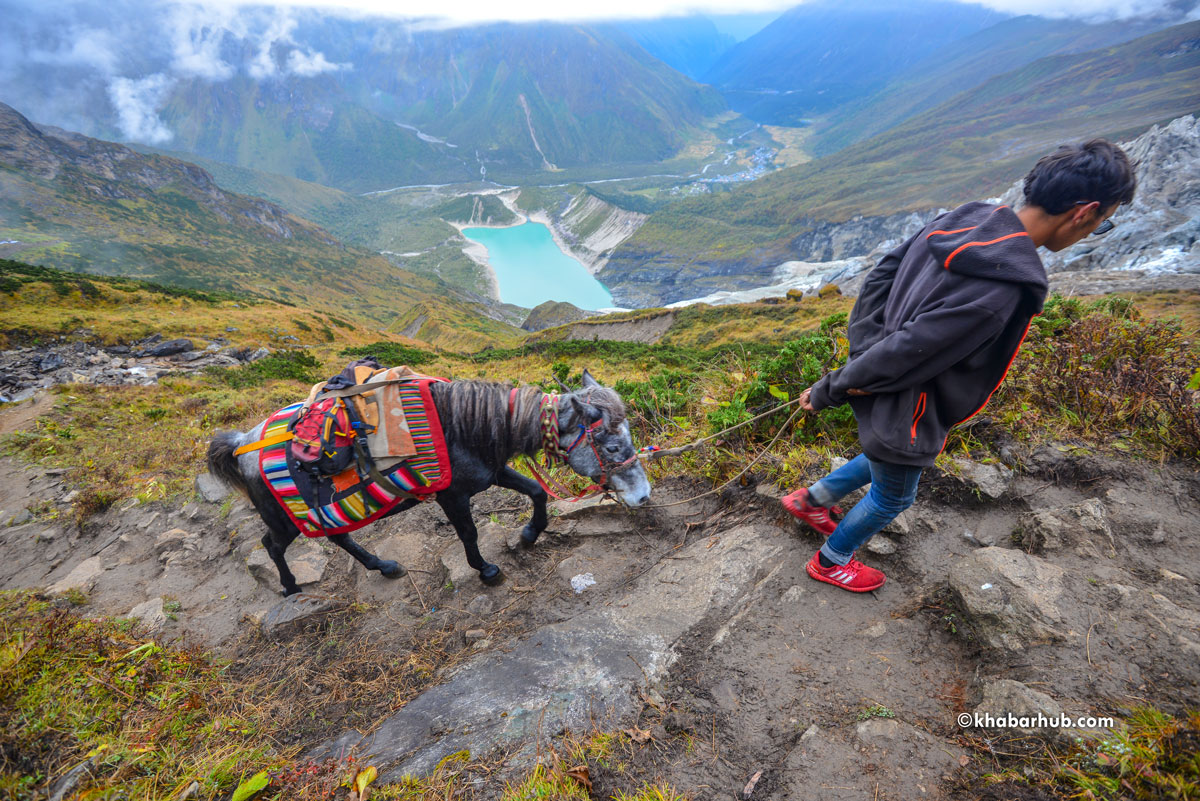
A man with a mule heading toward Manaslu basecamp (4800m). Donkey and mule are the major transportation means in the Manaslu Region.
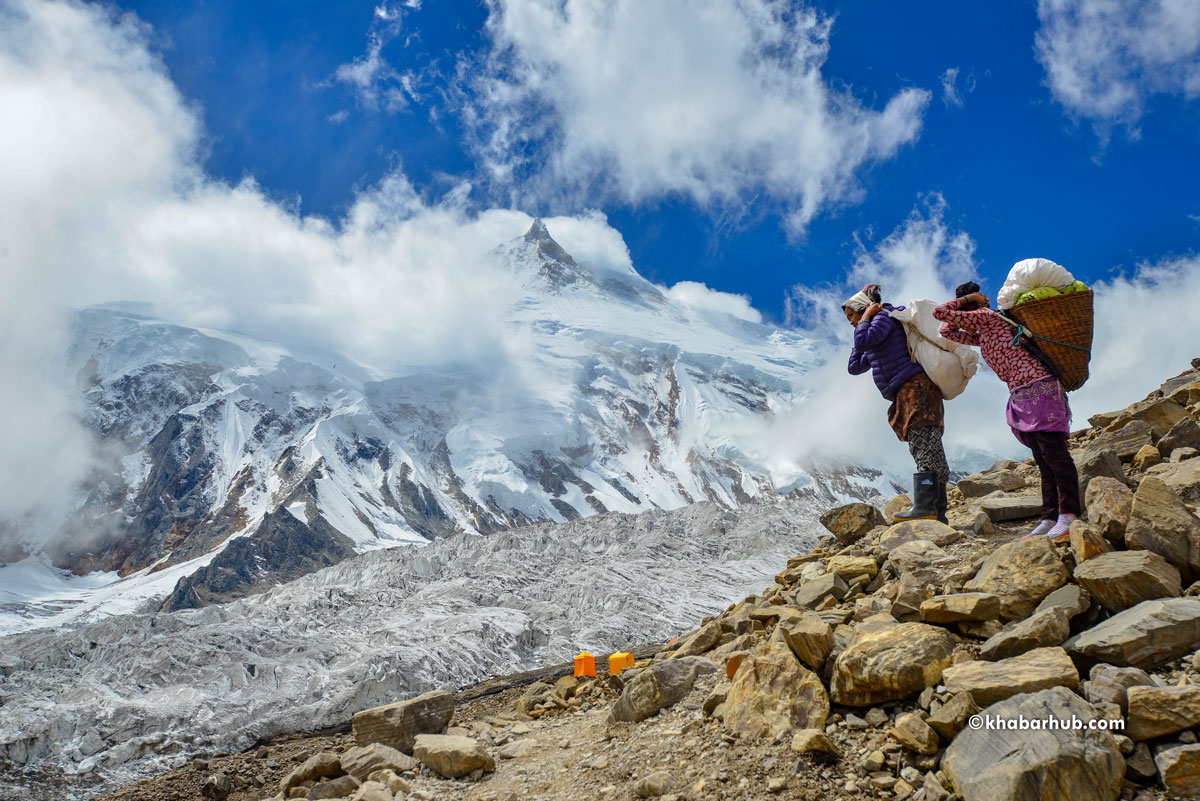
Two local women carrying loads to the Manaslu Base Camp.
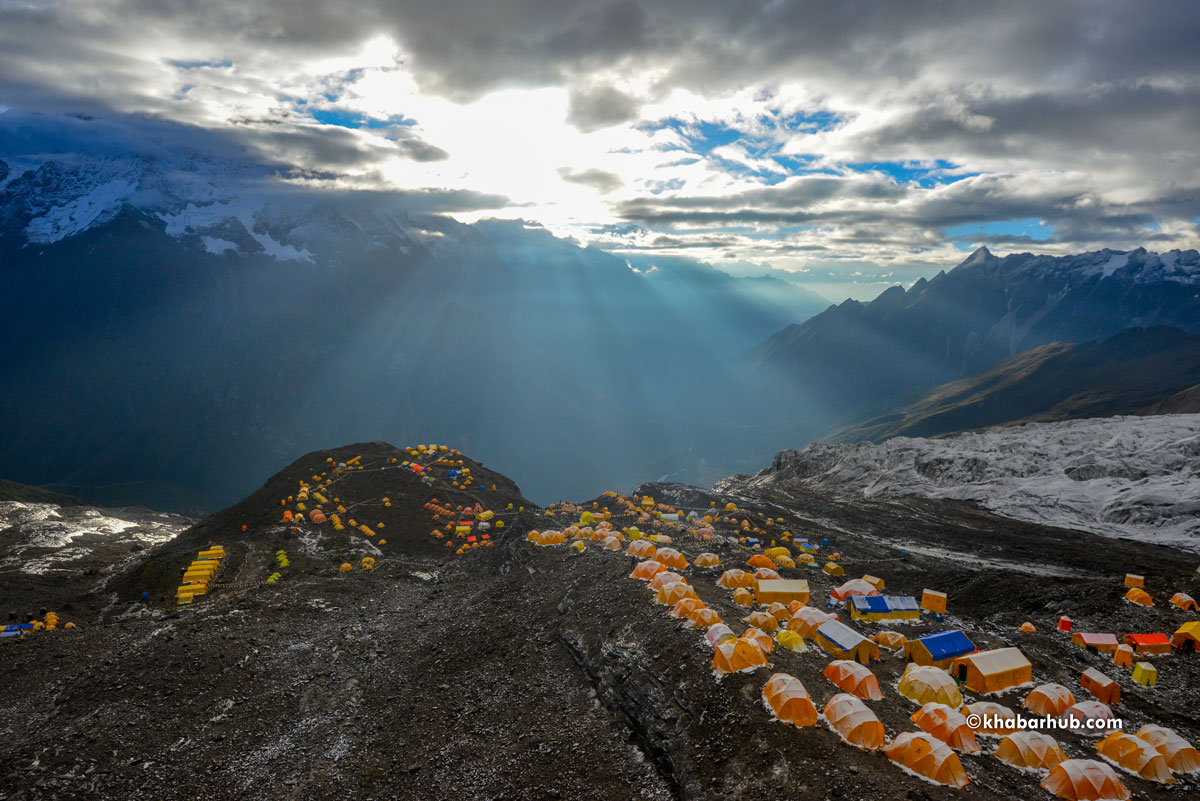
Tents at the Manaslu Base Camp (background is the Panpoche Peak 6620m). Climbers stay at the basecamp using tents for more than 30 days during the entire expedition. Each year more than 500 climbers climb the peak.
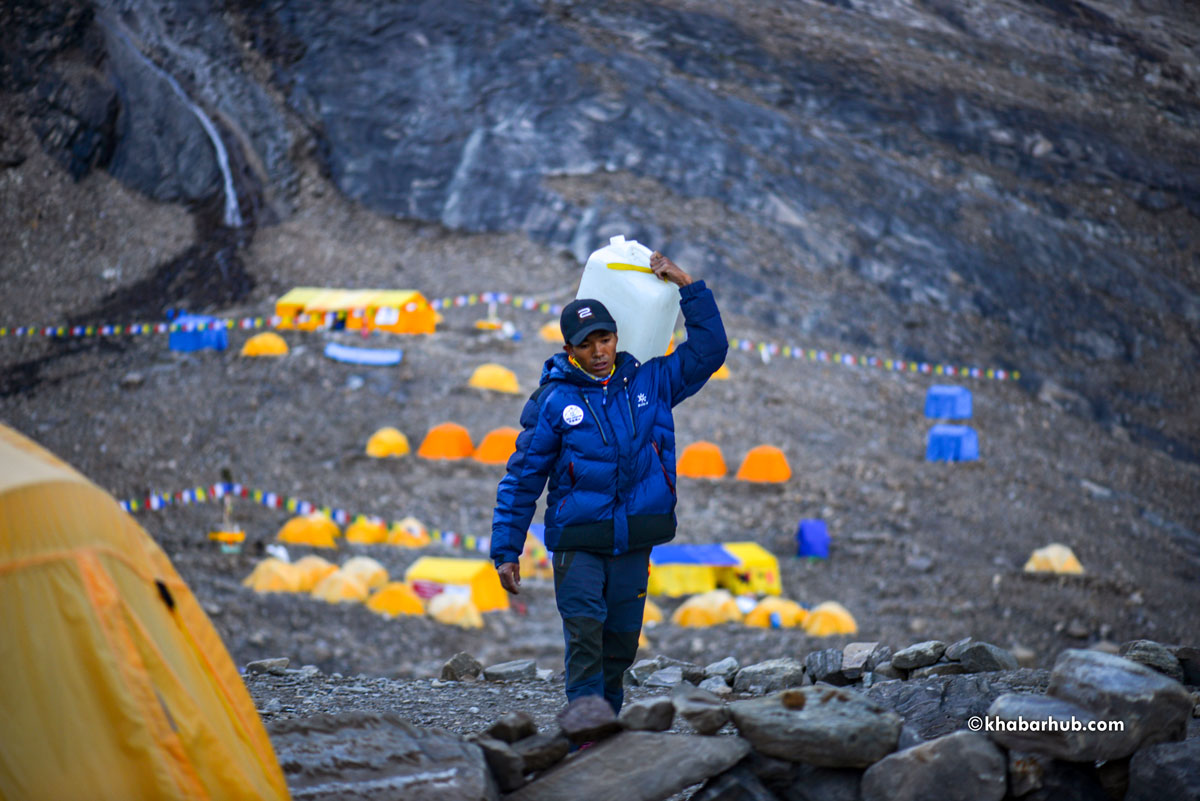
Man carry water from the source of melting ice at the basecamp.
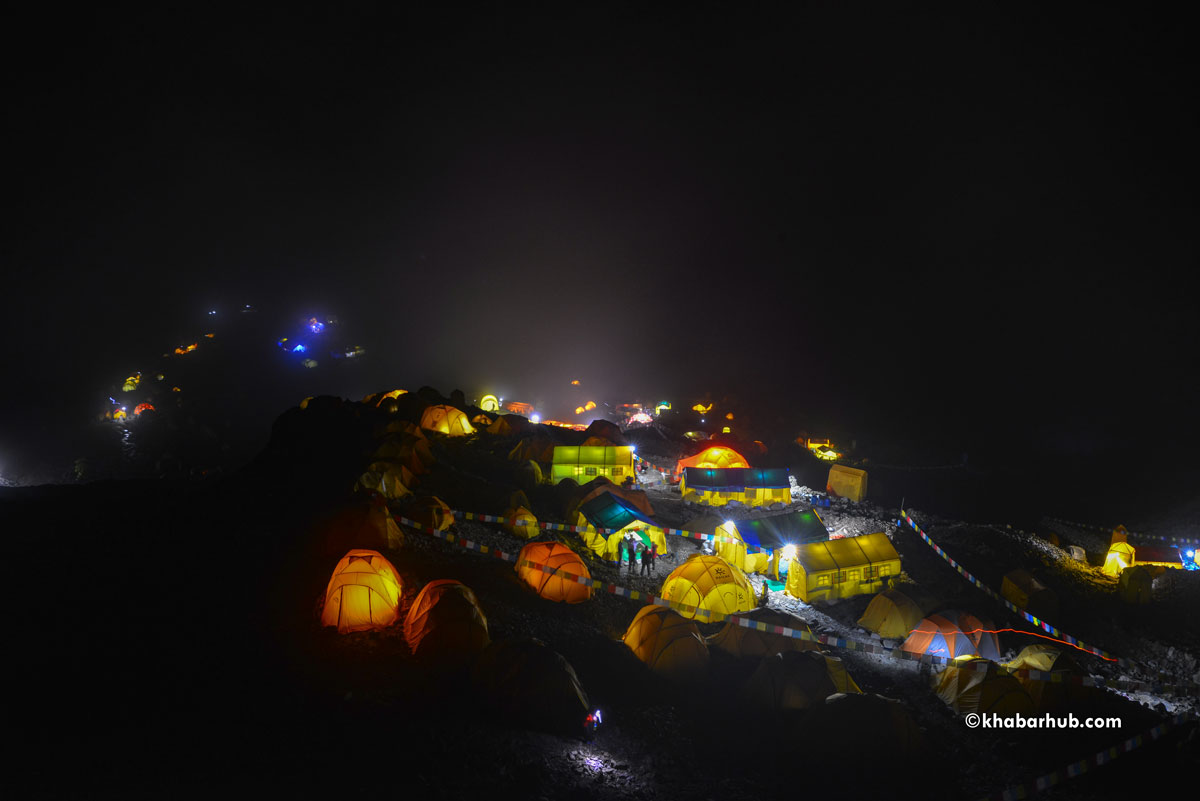
Lit up tents seen at the basecamp of Manaslu (4800m)
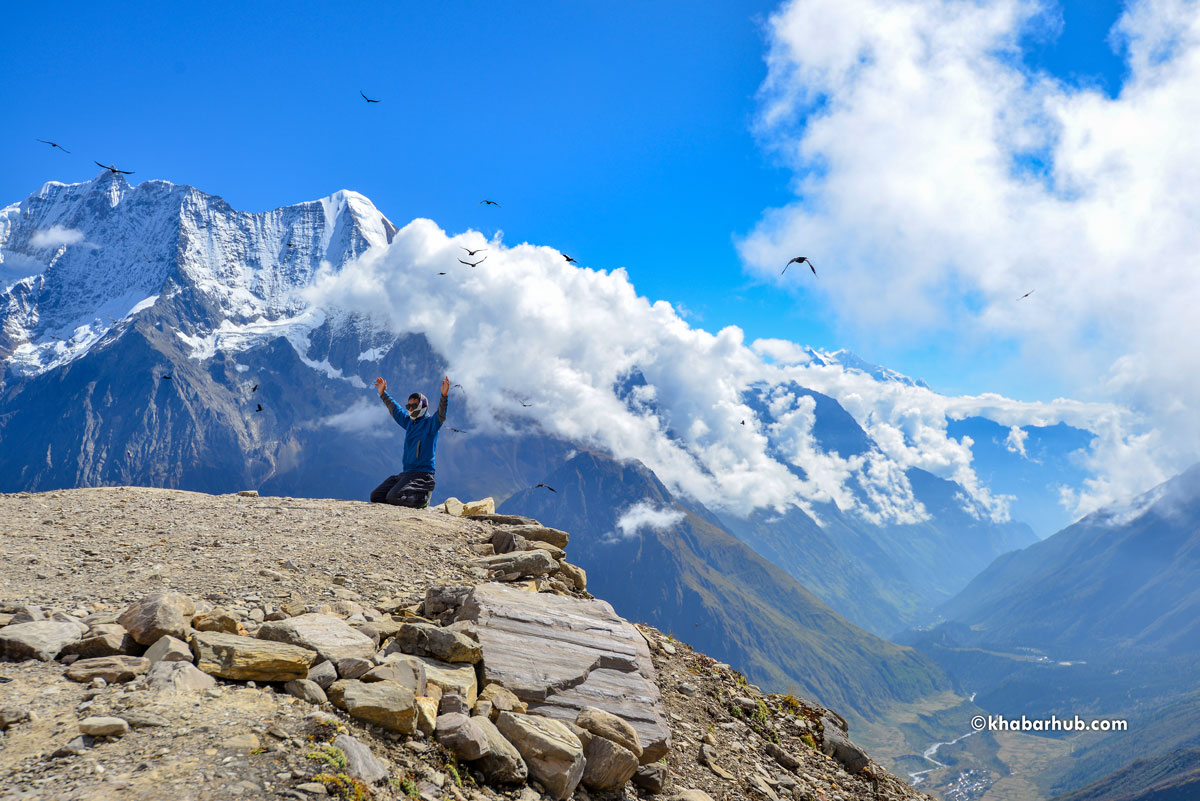
Man Marshaling helicopter at the basecamp. Some of the climbers chose to return to Kathmandu by helicopter after the climb. Helicopters are also used for rescue operations.
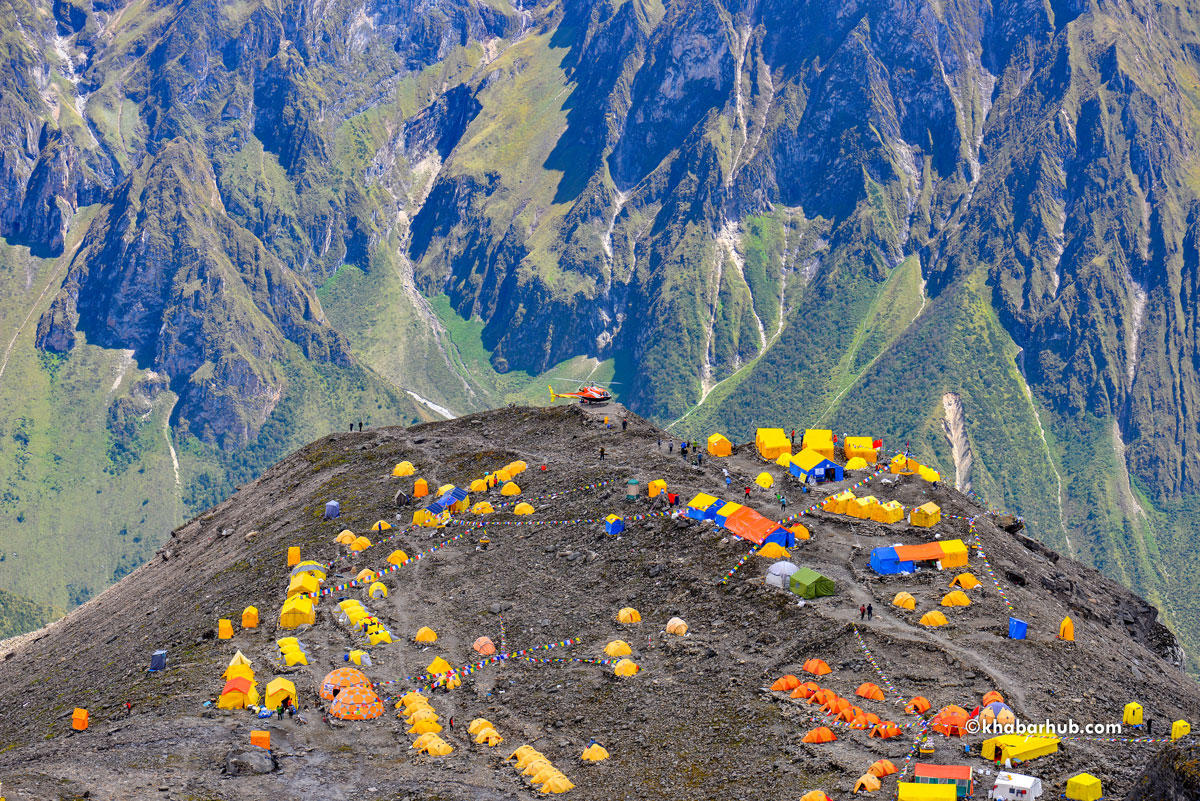
A chopper is seen at the Manaslu Base Camp.
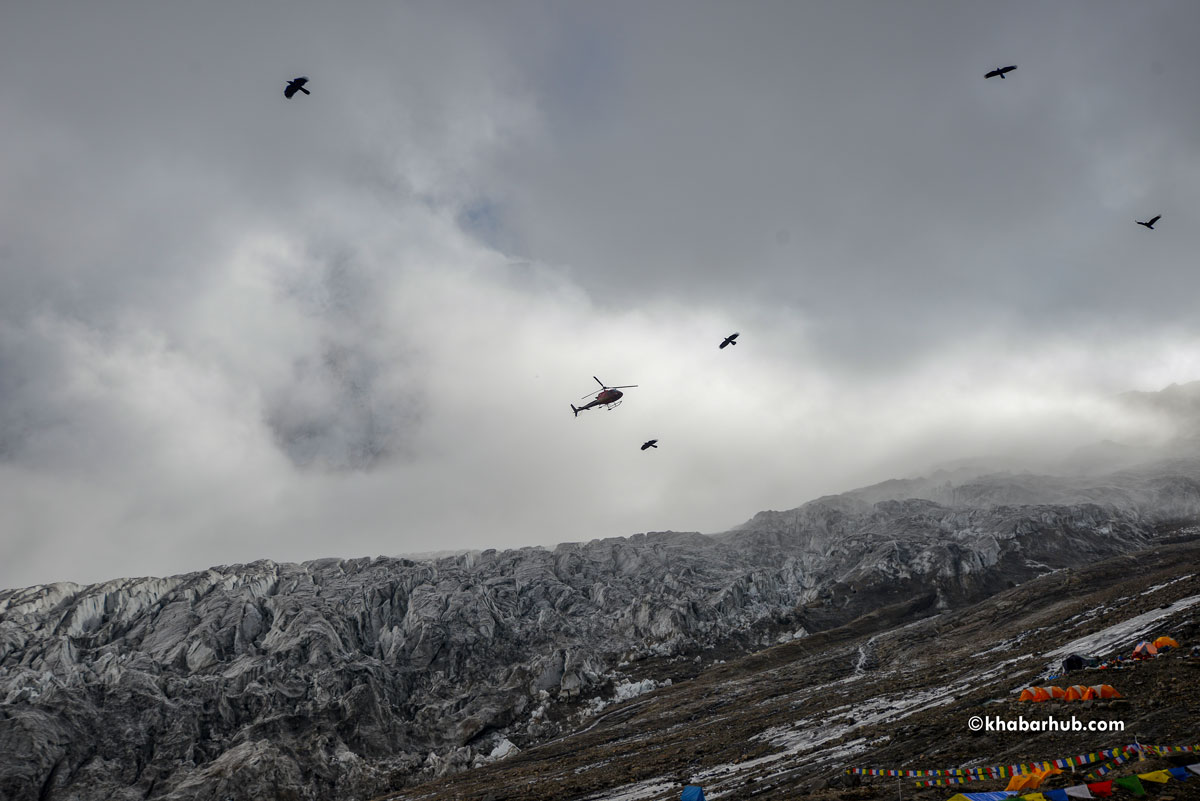
Helicopter and crows at the basecamp.
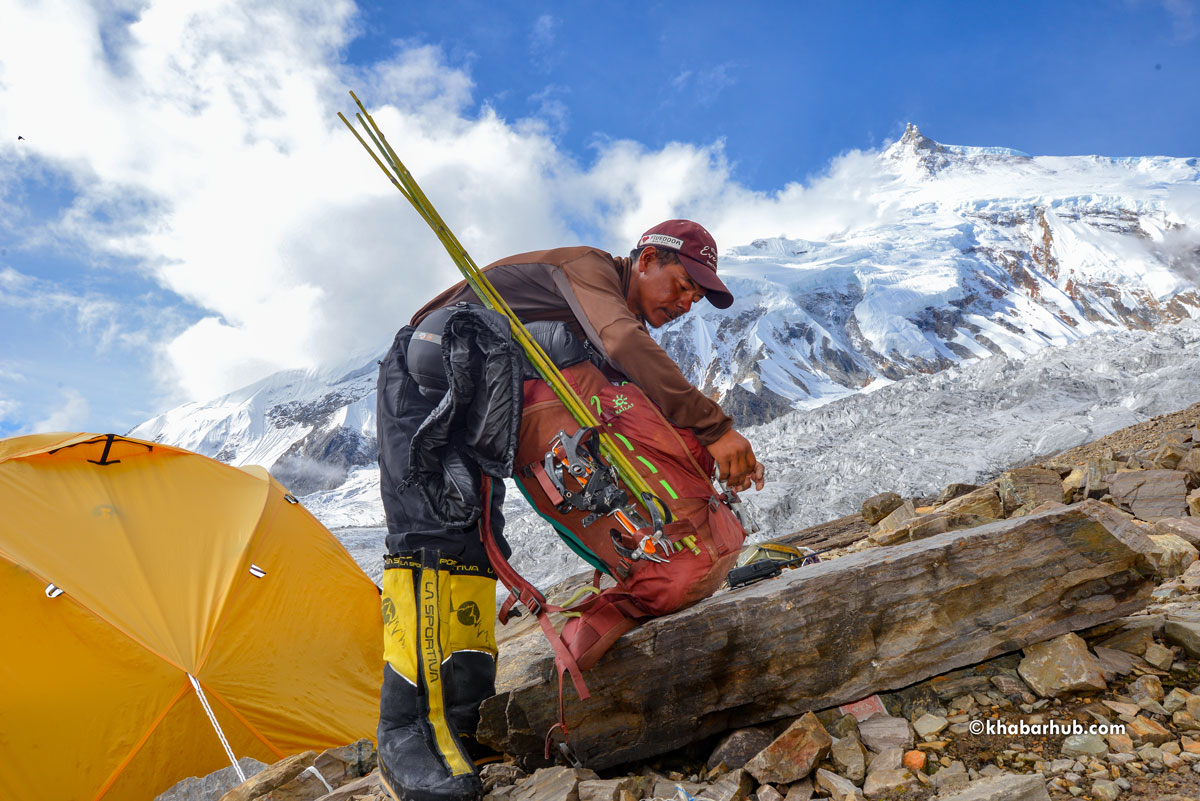
Sherpas preparing to go to the higher camp.
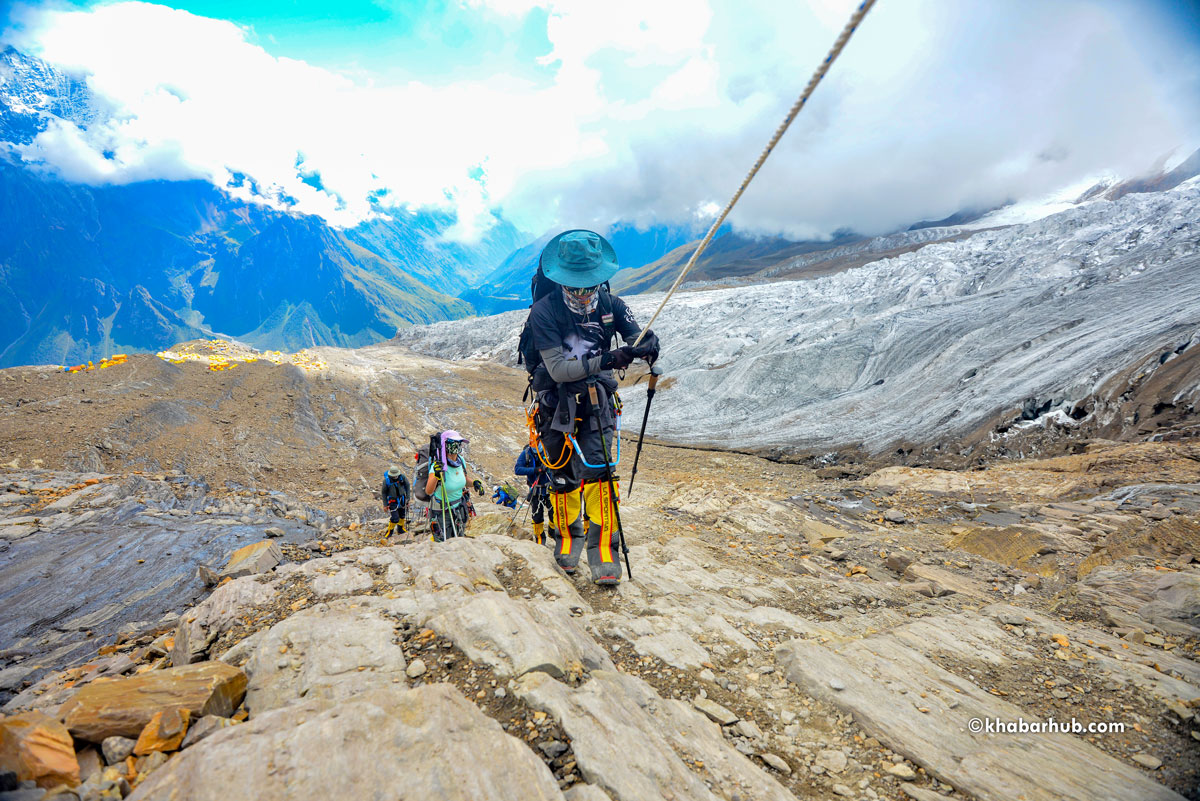
Climbers hiking towards Camp I from the base camp.
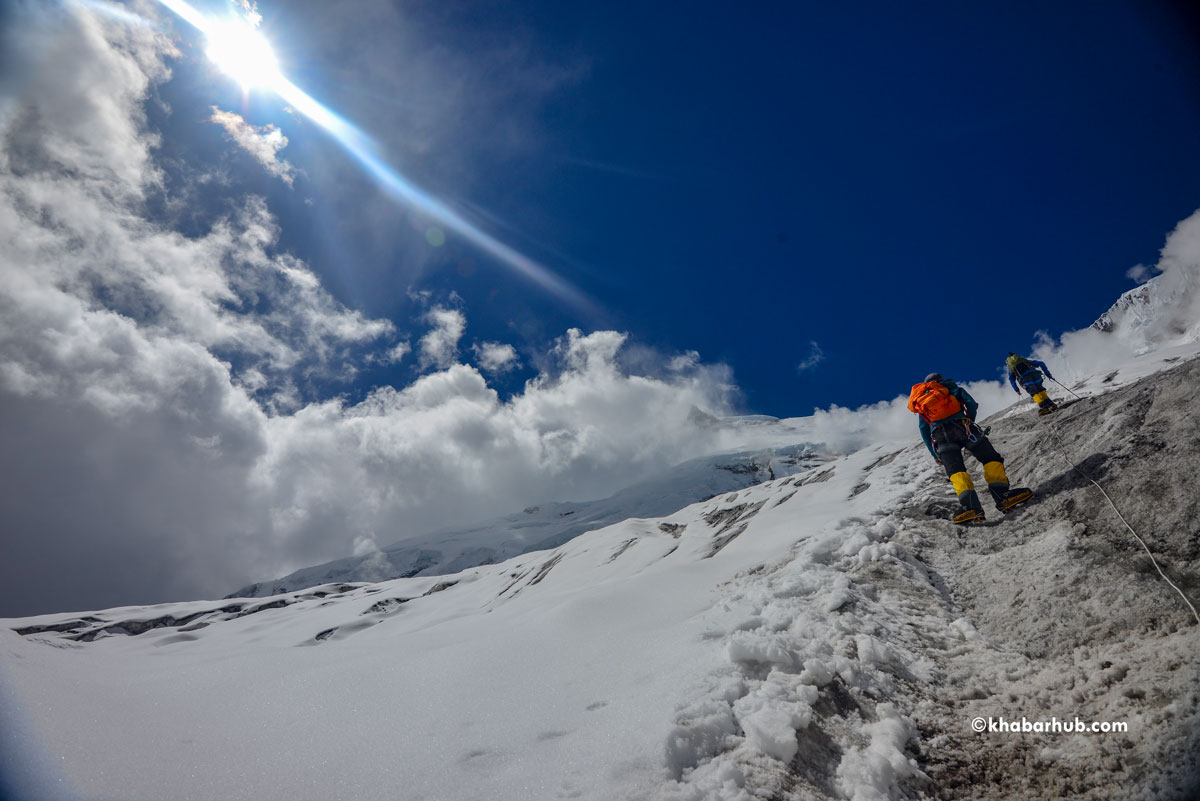
Climbers on the way to Camp 1.
KATHMANDU: View of Mt. Annapurna from Kothe Khola Rural Municipality -3, Dhamja, Baglung. Mt. Annapurna is the tenth highest mountain in the world at 8,091 meters (26,545 ft) above sea level.
Annapurna is a massif in the Himalayas in north-central Nepal that includes one peak over 8,000 meters, 13 peaks over 7,000 meters and 16 more over 6,000 meters.
The massif is 55 long, and is bounded by the Kali Gandaki Gorge in the west, the Marshyangdi River in the north and east, and by Pokhara Valley in the south. At the western end, the massif encloses a high basin called the Annapurna Sanctuary.
CHAUTARA: A mountaineering team led by Everest summiteer Maya Sherpa is all set to climb Gyalgen Peak that lies in the Jugal massif in Sindhupalchowk district.
The Jugal massif, that has many unclimbed peaks perched on the border between Nepal and Tibet, has a chain of 11 peaks. It lies in the Gumba village of Jugal Rural Municipality-3 in Sindhupalchowk district.
Sherpa’s eight-member team including another Everest summiteer Saral Sahayatri will leave Kathmandu on March 29 for climbing the 6,151 m- peak, shared team leader Gurung.
The Gyalen Peak is named after Mingma Gyalgen, the lead Sherpa of a three Scottish women team led by Monica Jackson that made the first ascent of then remote and unclimbed peak in the spring of 1955, according to a journal published by the America Alpine Club.
Gurung informed their estimated climbing period is 21-days. Sindhupalchowk is home district to Gurung and Sahayatri.
During the climb, their team will conduct research on the technical intricacies of climbing the Peak that is less frequently climbed by mountaineers given its remoteness despite its proximity with Kathmandu.
According to the Department of Tourism, the highest peak in the Jugal Himal range is Lyangpo Gyang Peak standing at 6,979 meter.
Gurung is not only Everest summiteer, she has also climbed the seven Summits, the highest mountains on the seven continents.
It takes a five-day trek to reach the first base camp of the Gyalgen Peak from Kathmandu to Paula Danda in Gumba of Sindhupalchowk, shared Jugal rural municipality ward member Himal Tamang.
Meanwhile, a commercial paragliding service was launched at Malachaur of Kadambas of Sagachowkgadhi Munciplaity-9 in Sindhupalchowk district for the first time.
Sagachowkgadhi Municipality Mayor Aman Singh Tamang on last Saturday launched the service introduced in the district by Nepal Paragliding and Hand-Gliding Association.
The paragliding service is believed to boost the local tourism in the district. Service seekers get to fly over the Sunkoshi Gaurishankar and Jugal Himal range from Lamachaur and land at Siranchaur of the same ward.
Dreams can be fulfilled if you have the burning desire. In fact, all journeys begin with a dream. For many, climbing the top of the world, Mt Everest could be a dream while some people might dream of reaching to the foot, the Everest Base Camp (EBC) at an altitude of 5,364 meters.
Reaching to the Everest Base Camp is now an achievable dream for those who want to glimpse the 8,848 meters summit. The EBC now has become one of the most popular adventure tourism destinations.
It will be a super adventure full of exciting moments, breathtaking snowy peaks, stunning glaciers, ancient monasteries, and ice falls, as well as the Sherpa culture and tradition.
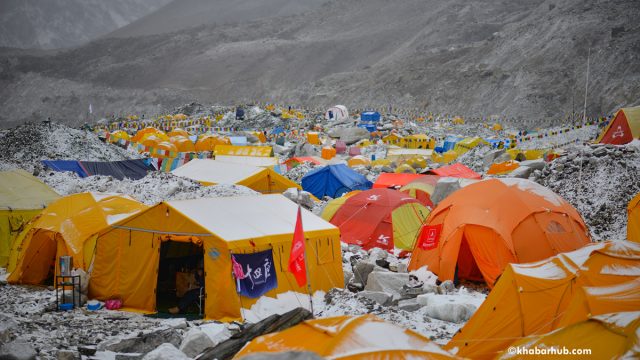
Tents at the Everest Base Camp. Climbers stay at the tent for around two months in each spring season.
Trek to the EBC can be enticing making it a lifetime experience for trekkers since this has been in the high priority list of trekkers.
Trekkers, however, cannot halt at the EBC, which is one of the most popular trekking routes in Nepal’s Himalayas. They have to return from there while climbers stay there for days before climbing the Everest.
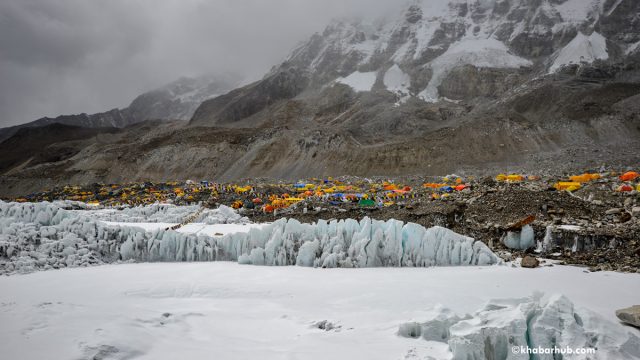
The EBC as seen from the Khumbu Icefall. In each season, around 2,500 trekkers and climbers come to the base camp.
Thousands of trekkers visit the EBC every year. Trekkers wishing save time and energy fly to Lukla, the gateway to Everest, from Kathmandu.
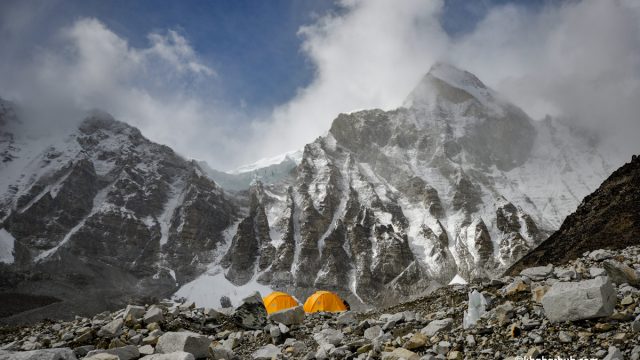
Tents at the EBC. Mt. Lingtren (6,749 m) is seen at the backdrop. Each tent accommodates only two persons.
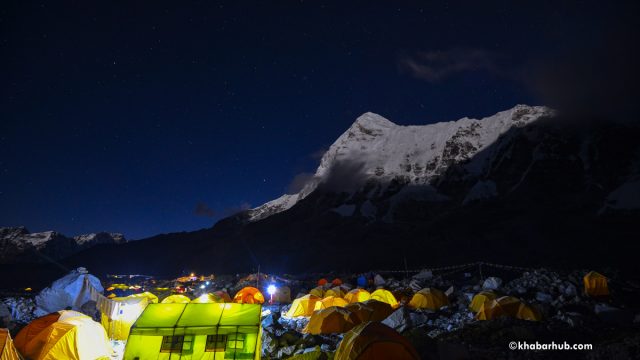
Tents at night. Mt. Pumori (7,161 m) is seen very close. The temperature at the EBC at night deeps down to a minimum of minus 20 degree Celsius.
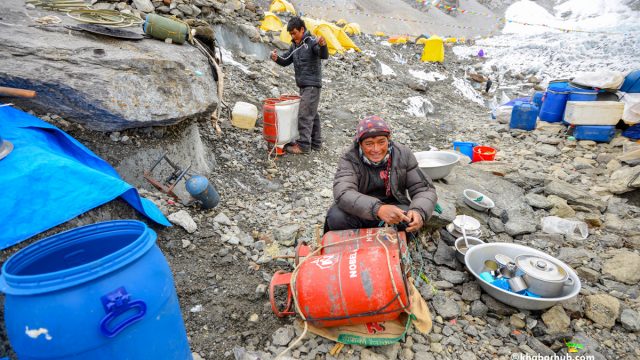
Porters are seen delivering gas cylinders at the base camp. Trekkers started using gas cylinders to cook food since the last one decade. The cylinders are also taken to the Mt Everest Camp 2.
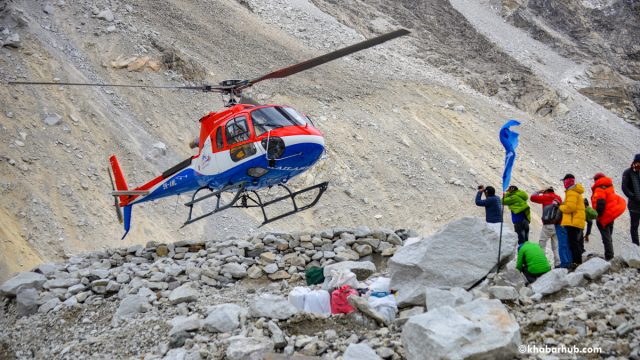
Helicopter is seen at the EBC. Trekkers also prefer choppers for viewing the Everest. Helicopters are also used in rescue operations.
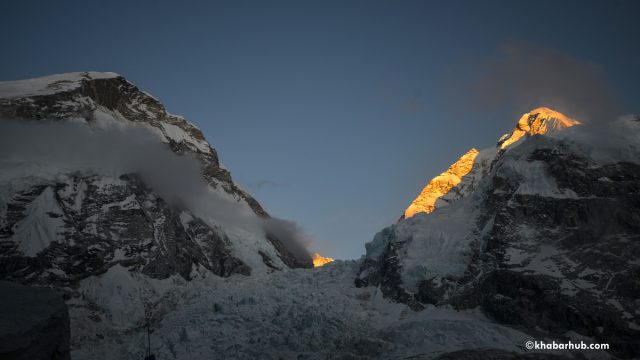
Sunrise seen at the ridge of Mt. Nuptse (7,861 m).
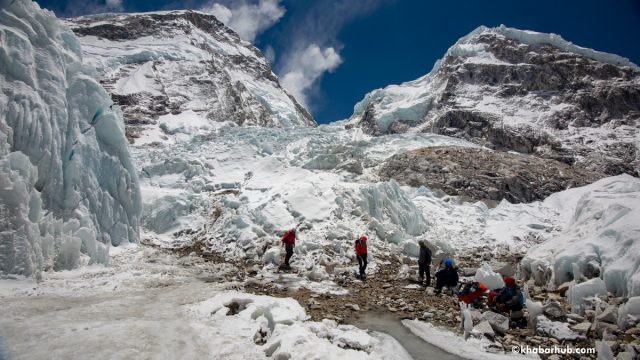
Trekkers, climbers making a round of the Khumbu Icefall as part of the expedition. Before climbing the Mt. Everest, each climber needs to make at least two rounds of the Khumbu Icefall.
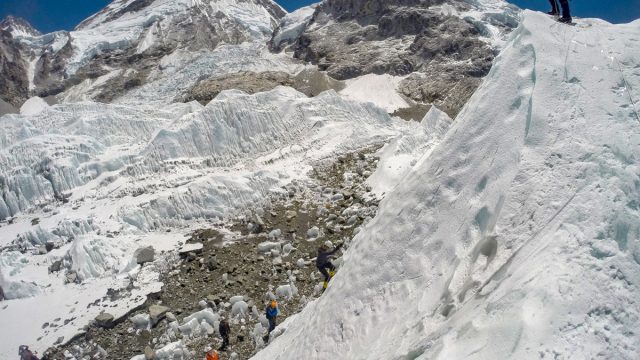
Climbers undergo training at the base camp before making their final climb. Climbers learn to use gear and equipment in the training.
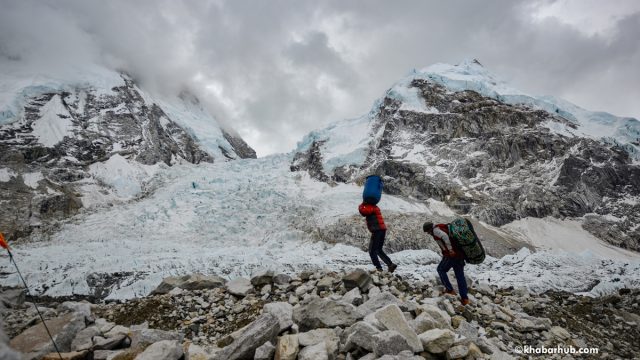
Porters carry the stuff back to the helipad.
Jangbu Sherpa, who has climbed the Mt. Everest for 15 times so far, reminisces a ‘touching’ moment what one of the American climbers had told him once while ascending the world’s highest peak.
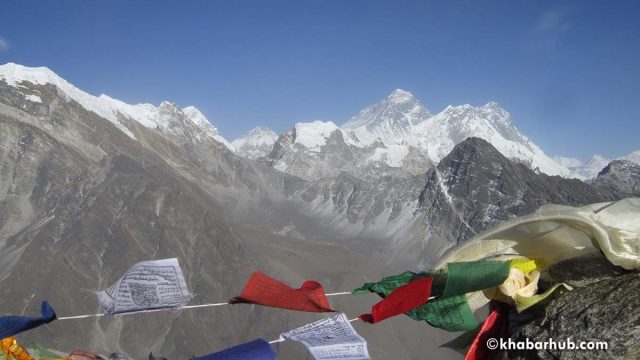
Sipping hot simmering coffee at Camp 2, and looking all around, the American climber had then told him, “Jangbu, see you have gold everywhere!”
This remarks touched Jangbu. “That was a metaphoric articulation. But, it was so striking that the expression remains itched in my mind ever since,” Jangbu shared his experience. In fact, the Everest has always been magical for him with mesmeric qualities. “Yes, Nepal’s mountains are as precious as gold,” he emphasizes.
What captivates him to the dreadful climbing time and again? “It’s the white towering peak,” pat comes the reply. He adds, “Making trips with summiteers from different parts of the world gives me a sense of satisfaction blended with pleasure.”
For Jangbu who is a famed Sherpa guide and an instructor, climbing Mt Everest is a never ending dream. Therefore, he is set for the 16th ascent, this spring. Jangbu, 37, has been guiding foreign climbers for the last 18 years since he first ascended the world’s highest summit in 2003 as a porter and helper at the age of 21.
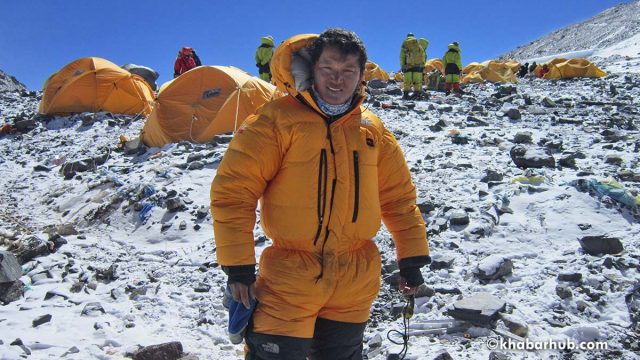
Now, he is a trained guide who leads countless treks and climbs with his clients, mostly from America, Europe and Australia.
What captivates him to the dreadful climbing time and again? “It’s the white towering peak,” pat comes the reply. He adds, “Making trips with summiteers from different parts of the world gives me a sense of satisfaction blended with pleasure.”
According to Jangbu, Nepal’s high mountains have always lured them (foreigners) since conquering the Everest is a lifelong dream for any climbers.
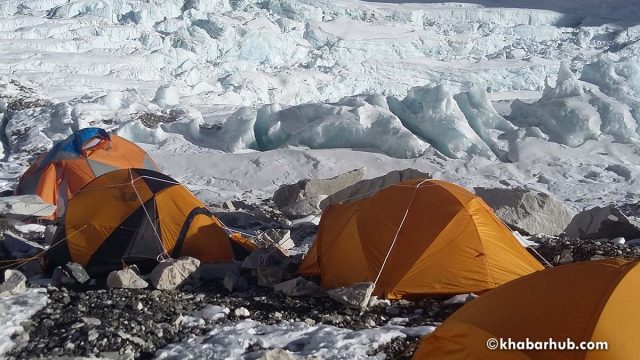
This season, he will be joining hundreds of climbers from several countries at the Base Camp to make a bid for the 8,848 meters tall summit.
“Yes, I am excited to climb the Everest for the 16th time this season,” an enthusiastic Jangbu said adding that the death rate in the expedition has declined in recent times. Reason: the experience gained by the climbers and the guides.
He is, however, concerned about the waste littered all around the base camps, which according to him has been creating problems giving the area a filthy look. He suggests the government needs to organize a cleaning campaign on an annual basis by entrusting at least 10 Sherpas for the task.

He is equally concerned about the government’s ambitious plan to attract at least 2 million tourists in 2020. “Merely printing advertisement t-shirts and wearing them does not work. Nepal Tourism Board (NTB) and the government should focus more on publicity campaign,” suggests the veteran climber.
Climbers from across the world dream of scaling the top of the world, Mt. Everest. However, achieving the daring feat is challenging. But not to the Sherpas, people from an ethnic community of Nepal in the Himalayan region. In fact, Sherpas are synonymous to the Everest.
While it may be a passion to many climbers, scaling the Everest has been ancestral profession to the Sherpas who are working as porters and guides to mountaineers for a long time.
While mountain climbing is nothing new to Sherpas, Kami Rita Sherpa has carved a niche in this sector. Incredible it may sound but he has climbed Mt. Everest, the world’s highest peak for 22 times — between 13th of May 1994 to 16th May 2018.
This 49-year-old of Thame, Solukhumbu first ascended the highest peak on 13 May 1994. Since then there is no looking back for him.
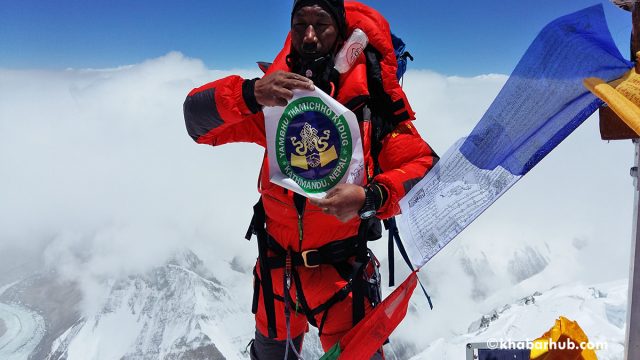
He has also climbed Annapurna IV in 1996, Cho Oyu 8188m for 8 times from 2001 to 2011, LhoTse 8,516m in 2011, Mt. K2 (8,611m) in 2014, and Manaslu (8,163) in 2017.
Born on 19 Jan 1970, he has so far made 34 successful summits over 8000m peaks.
Kami Rita is currently working as a senior climbing guide at Seven Summit Treks and 14 Peak Expedition P. Ltd, sister companies.
Ask him his future plans and he would say: “I want to climb Mt. Everest for another five times.”
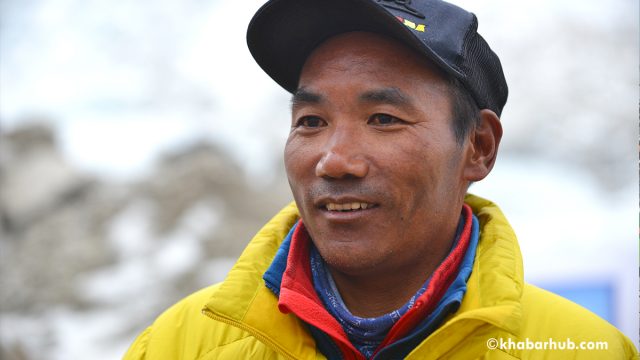
“I will continue to climb until my health permits me,” he said His village folk call him “record-holder Kamirita” since there are quite a few of his name in his village.
Kami started his job as a porter at the age of 12, and he succeeded in reaching atop the Mt. Everest when 24 on the 13th of May, 1994.

The government allows a permit of 75 days for Everest Summiteers. They stay at Sagarmatha Base Camp for 35 to 40 days before setting off for the climb.
It is necessary for a climber to stay at the base camp for acclimatization. In the camp, they sing, dance, cook and enjoy, says Kami. According to him, they take the climbers to Camp One, Camp Two, and Camp Three, and return to the Base Camp. Till camp two, we cook ‘Dal and Bhaat’, Kami Rita said.
“Rather than making or breaking records, my aim is to attract foreign climbers specially to the Mount Everest and the snow capped Himalayas of Nepal contributing to its tourism development,” he said revealing his motive behind his repeated mission to world’s peak.
Kami says he earns Rs. one to 1.2 million while climbing the Mt. Everest.
Mt Everest, world’s highest peak, brings hundreds of adventure aspirants in a season from around the world.
If anyone asks you why do you climb Mt Everest, then pat comes the famous answer of climber George Mallory: “Because it is there!”
Day one:
Kathmandu to Phakding via Lukla

Photo: Thaneswar Guragai
Fly from Kathmandu to Lukla (2800 meters) and then trek for three hours to reach Phakding covering a distance of approximately 8km. Stay overnight at Phakding and stay at a lodge with a two-star facility.
Day two and day three
Phakding to Namche
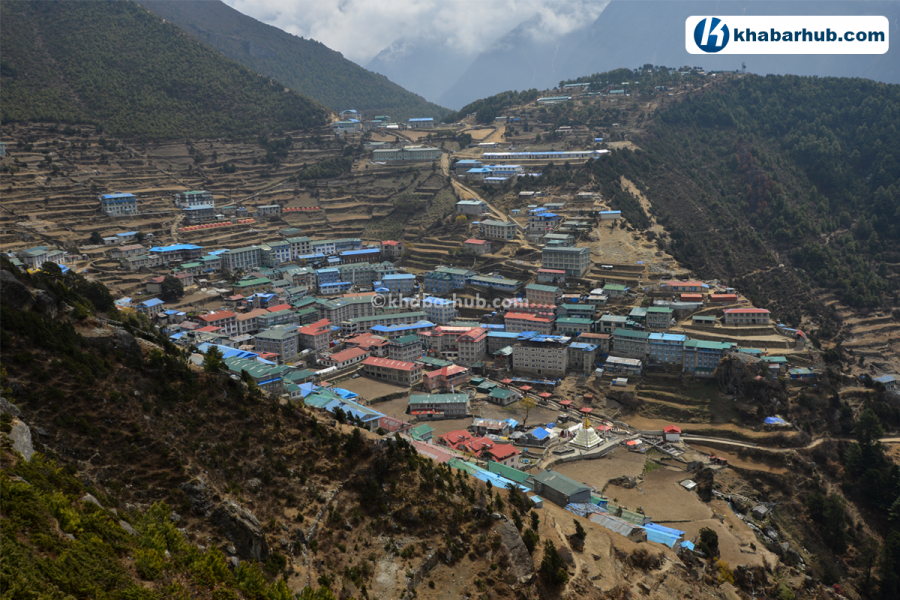
Photo: Thaneswar Guragai
After breakfast at Phakding, trek to Namche Bazaar, gateway to Everest, located at the height 3,440 meters. Namche Bazaar is also the entry of Sagarmatha National Park. Stop on the way for lunch and snacks enjoying the exotic Himalayan range. Reach Namche bazaar in around six hours covering a distance of around 11km. Two overnight-stay at Namche Bazaar. In the second day, tourists normally visit Everest View Hotel, listed as a hotel located in the highest altitude.
Enjoy the local culture and spend the day around Namche Bazaar. Overnight stay at Namche Bazaar for acclimatization.
Day four
Namche to Tengboche
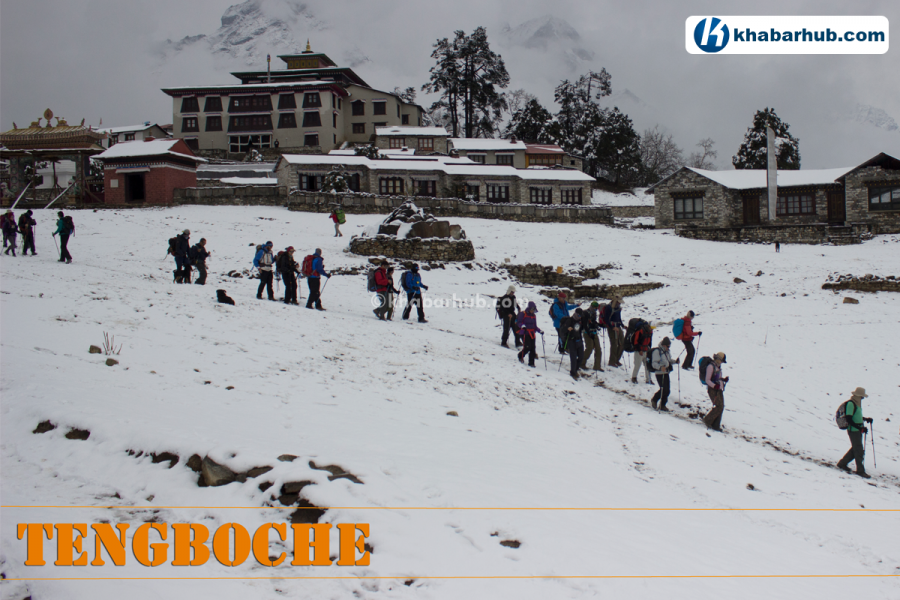
Photo: Thaneswar Guragai
After breakfast, trek from Namche to Tengboche covering a distance of around 11km within five hours. Overnight stay at Tengboche. Tengboche is located at the height of 3860 meters. Tengboche monastery is the main attraction. It offers a panoramic view of the Everest, Nuptse, Lhotse, Ama-Dablam and other Himalayan ranges. Overnight stay at Tengboche.
Day five
Tengboche to Dingboche
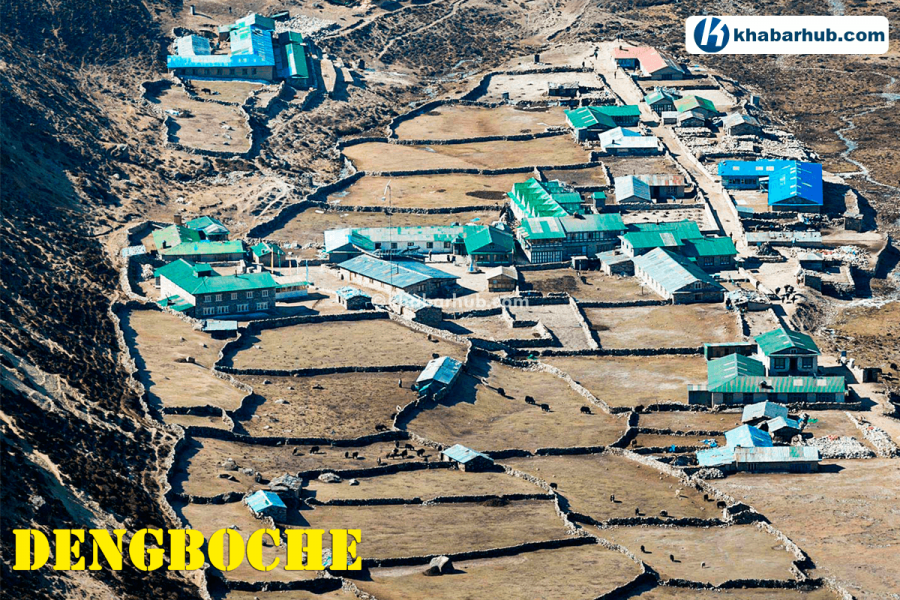
Photo: Thaneswar Guragai
After breakfast, trek to Dingboche from Tengboche covering a 5-hour-trek of around 12km. Located at the height of 4,250 meters, you will reach Dingboche, a Sherpa village, which is preferred for acclimatization. In the first successful Everest expedition in 1953 by Tenzing and Edmund Hillary, this place had served as the Everest Base Camp. Thanks to global warming, Dingboche does not possess as much snow now.
Day six and seven
From Dingboche to Lobuche
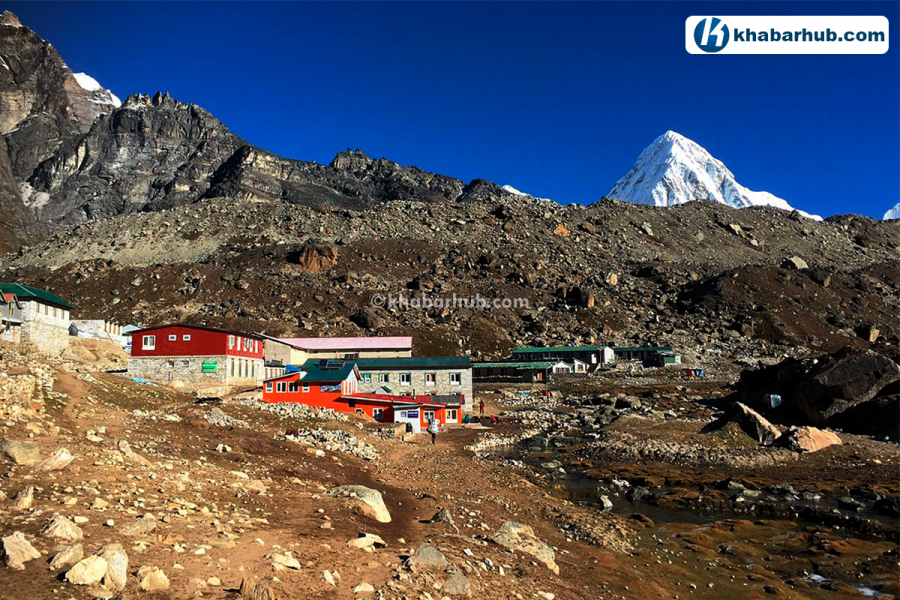
Photo: Thaneswar Guragai
After breakfast, trek from Dingboche to Lobuche covering a distance of some 12km in around five hours. Overnight stay at Lobuche, a Sherpa village located at the height of 4930 meters. It is located in the lap of Lobuche peak (6,119 meters). Most of people prefer to ascend Lobuche peak as part of acclimatization.
Day eight
Lobuche to the Everest Base Camp
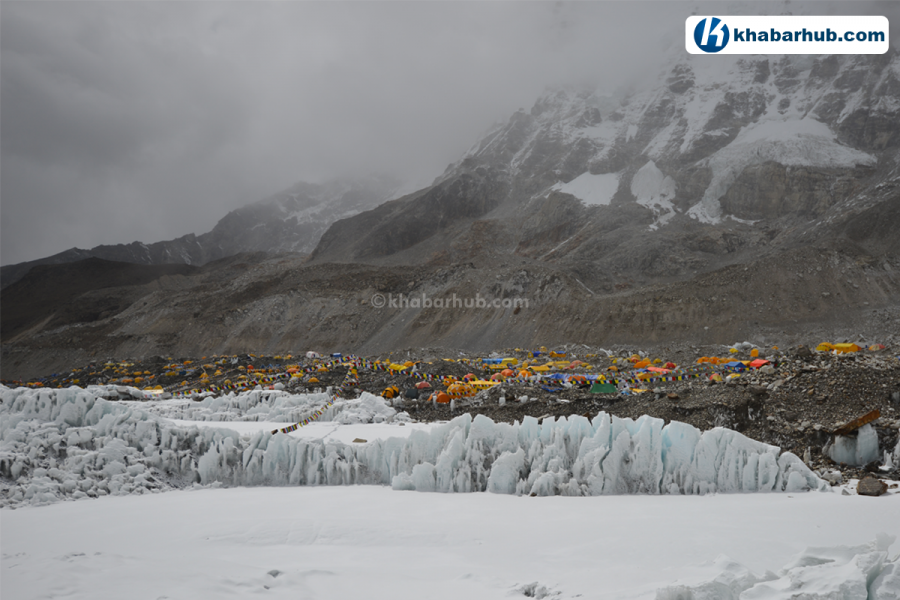
Photo: Thaneswar Guragai
After breakfast at Lobuche, head to the Everest Base Camp covering a distance of around 15km in eight hours. It is basically taken as a dream camp for trekkers, the starting point for climbers. Around 1,800 to 2,200 people are seen around the base camp during spring each year spreading tents waiting for more than 600 climbers to Everest, Lhotse, and Nuptse. The base camp resembles a bazaar.
People rest at the base camp for around five to six days and then begin their climbing training.
Camp One (6050 meters)
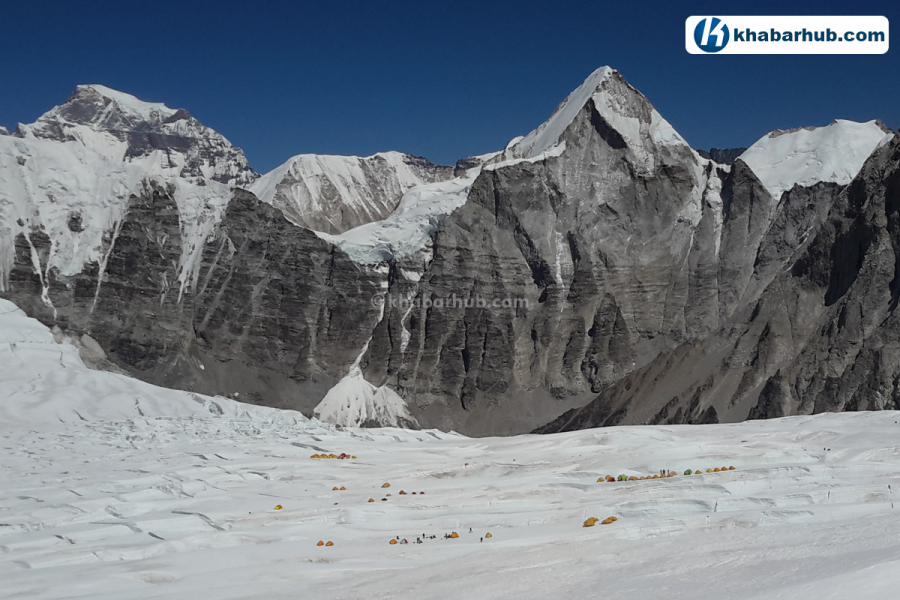
Photo: Thaneswar Guragai
From the Everest Base Camp starts the journey of the Everest ascent. Camp One is extremely challenging due to the notorious Khumbu icefall.
Camp two (6500 meters)
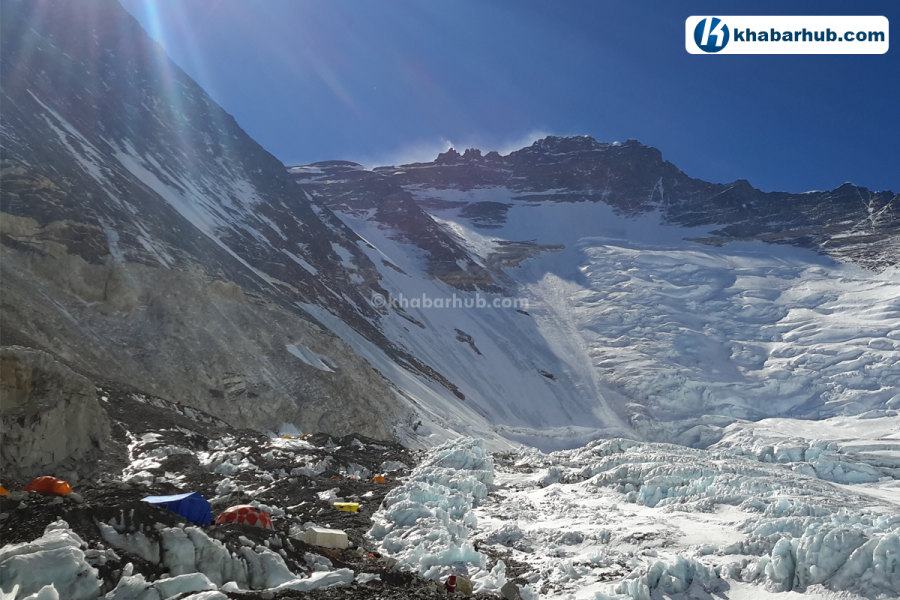
Photo: Thaneswar Guragai
Camp Two is rather easy with a slightly sloppy route. It is set against the southern wall of the Everest. Climbers stay more than two nights at Camp Two as part of the climbing rotation (for acclimatization).
Camp three (7200 meters)
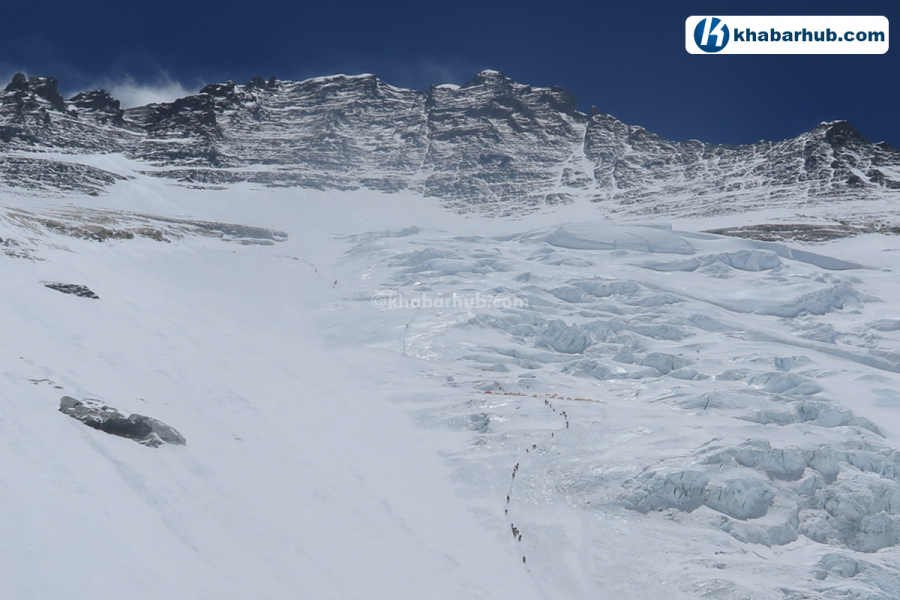
Photo: Thaneswar Guragai
Camp three serves as the resting place for climbers and is fixed on the sloppy area of Lhotse face. Reaching Camp Three is difficult because of the stiff climb. Climbers use crampons and ice axe to reach the camp.
Camp Four (South Col) (7900 meters)
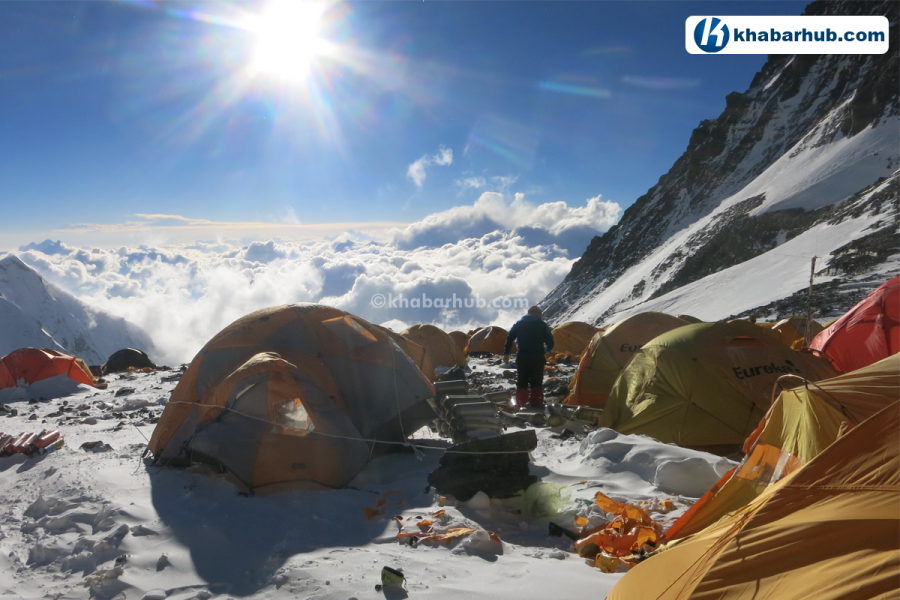
Photo: Thaneswar Guragai
Sherpas deposit oxygen, and other gears and materials at this camp. It serves as the base camp for the summit push. This means there are no other camps from Camp Four to the top of the Everest. The journey to and fro from this camp to the top requires 16 to 18 hours.
Hillary Step
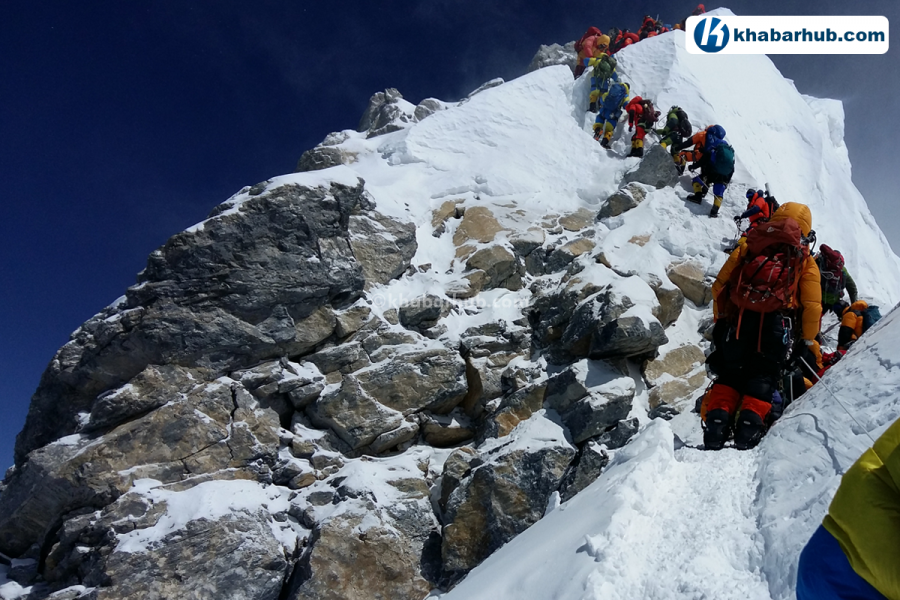
Photo: Thaneswar Guragai
This lies at the height of 8,790 near the summit. This step is named after Edmund Hillary. Until 2015, this step was very challenging because the climbing route lied in amidst huge boulders and passing through was difficult. Climbers often got stuck and even faced death. However, thanks to the massive 2015 earthquake, boulders have made the climb easy and smooth.
Everest Summit (Third Pole)
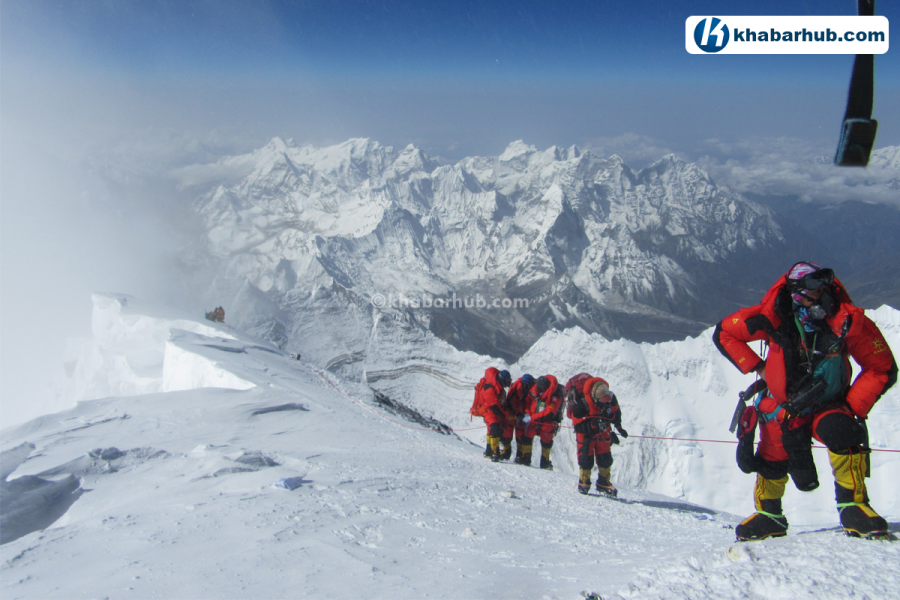
Photo: Thaneswar Guragai
The summit measuring 8,848 meters is the ultimate goal of the climbers where they spend five to ten minutes. It provides a close view of Mt. Cho-Oyu and Mt. Makalu. One can have a clear view of the landscape on the Nepal and Tibet sides. Around 8,000 climbers, including Sherpas, have made it to the summit so far.
KATHMANDU: A total of 42 Nepali women have scaled the Mt. Everest so far. Pasang Lhamu Sherpa reached the world’s highest summit on April 22, 1993, becoming the first Nepali woman to conquer the third pole, according to the Department of Tourism.
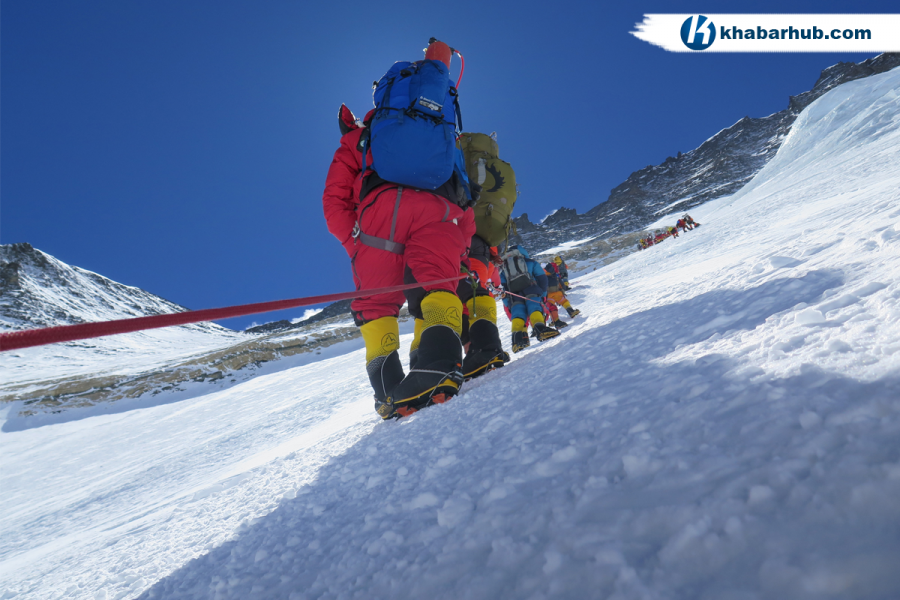
Lakpa Sherpa of Sankhuwasabha holds the record among the Nepali women scaling the Mt. Everest for nine times. Born at a remote village Tashigaun, Makalu-Barun in Sankhuwasabha, Lakpa started her mountaineering career as a helper of a trekking group 17 years ago. She reached the top in 2000, 2001, 2003, 2004, 2005, 2006, 2016, 2017 and 2018.
In 2008, a total of 10 Nepali women made it to the peak. Likewise, 1993, 2001, 2004, 2009 and 2013 witnessed a single woman each scaling the mountain, according to the record.
According to the record maintained by the Ministry of Culture, Tourism and Civil Aviation, as many as 18 women scaled the world’s highest peak in 2018, the highest record ever. Those include Rosha Basnet, Rojita Buddhacharya, Deurali Chamling, Phunjo Jhangmu Lama, Kalpana Maharjan, Chhoki Sherpa, Dabuti Sherpa, Dawa Diki Sherpa, Dikki Sherpa, Doma Sherpa, Lakpa Yangi Sherpa, Lakpa Sherpa, Nima Jangmu Sherpa, Pasang Lhamu Sherpa, Yangdi Sherpa, Purnima Shrestha, Kanchhi Maya Tamang, Lukme Tamang. Basnet and Shrestha are journalist and photojournalist respectively, according to the data available at the department .
In 2008, a total of 10 Nepali women made it to the peak. Likewise, 1993, 2001, 2004, 2009 and 2013 witnessed a single woman each scaling the mountain, according to the record.
Likewise, Maya Sherpa of Patle 5, Okhaldhunga conquered Mt Everest three times. Similarly, Sushmita Maskey, Ming Kipa, Ngawang Phuti, Pemba Doma Thaktopa Sherpa and Kanchi Maya have climbed the peak two times each.
Most of the women who conquered Mt. Everest belong to the Sherpa community. Out of 42 climbers, 21 of them belong to the Sherpa community whereas others represent the Tamang, Newar, Gurung, Limbu, Rai, Brahmin and Chhetri communities. Pasang Lhamu Sherpa is the only woman climber who died after climbing the Mt. Everest successfully.
| YEAR | NAME |
| 2018 | Rosha Basnet |
| 2018 | Rojita Buddhacharya |
| 2018 | Deuralee Chamling |
| 2018 | Phunjo Jhangmu Lama |
| 2018 | Kalpana Maharjan |
| 2018 | Chhoki Sherpa |
| 2018 | Dabuti Sherpa |
| 2018 | Dawa Diki Sherpa |
| 2018 | Dikki Sherpa |
| 2018 | Doma Sherpa |
| 2018 | Lakpa Yangi Sherpa |
| 2018 | Lakpa/Lhakpa Sherpa |
| 2018 | Nima Jangmu Sherpa |
| 2018 | Pasang Lhamu Sherpa |
| 2018 | Yangdi Sherpa |
| 2018 | Purnima Shrestha |
| 2018 | Kanchhi Maya Tamang |
| 2018 | Luckme Tamang |
| 2017 | Bhumira Gurung |
| 2017 | Nanu Maya Gurung |
| 2017 | Lakpa/Lhakpa Sherpa |
| 2017 | Kanchhi Maya Tamang |
| 2016 | Lakpa/Lhakpa Sherpa |
| 2016 | Maya Sherpa |
| 2013 | Nisha Adhikari |
| 2012 | Beena Magar |
| 2012 | Dawa Yangzum Sherpa |
| 2012 | Ngim Chhamji Sherpa |
| 2011 | Susmita Maskey |
| 2011 | Chhurim Dolma Sherpa |
| 2011 | Ngawang Bhutik (Nawang Futi) Sherpa |
| 2009 | Junita Sambahamphe |
| 2008 | Pujan Acharya |
| 2008 | Shaile Basnet |
| 2008 | Usha Bista |
| 2008 | Maya Gurung |
| 2008 | Susmita Maskey |
| 2008 | Ngawang Bhutik (Nawang Futi) Sherpa |
| 2008 | Nima Doma Sherpa |
| 2008 | Pema Diki Sherpa |
| 2008 | Chunu Shrestha |
| 2008 | Asha Kumari Singh |
| 2007 | Maya Sherpa |
| 2007 | Mingkipa Sherpa |
| 2007 | Pasang Lhamu Sherpa |
| 2006 | Lakpa/Lhakpa Sherpa |
| 2006 | Maya Sherpa |
| 2005 | Moni Mulepati |
| 2005 | Lakpa/Lhakpa Sherpa |
| 2004 | Lakpa/Lhakpa Sherpa |
| 2003 | Lakpa/Lhakpa Sherpa |
| 2003 | Mingkipa Sherpa |
| 2002 | Pemba Doma Thaktopa Sherpa |
| 2001 | Lakpa/Lhakpa Sherpa |
| 2000 | Lakpa/Lhakpa Sherpa |
| 2000 | Pemba Doma Thaktopa Sherpa |
| 1993 | Pasang Lhamu Sherpa |